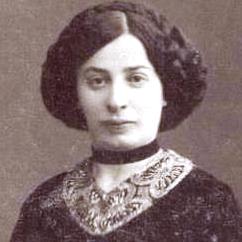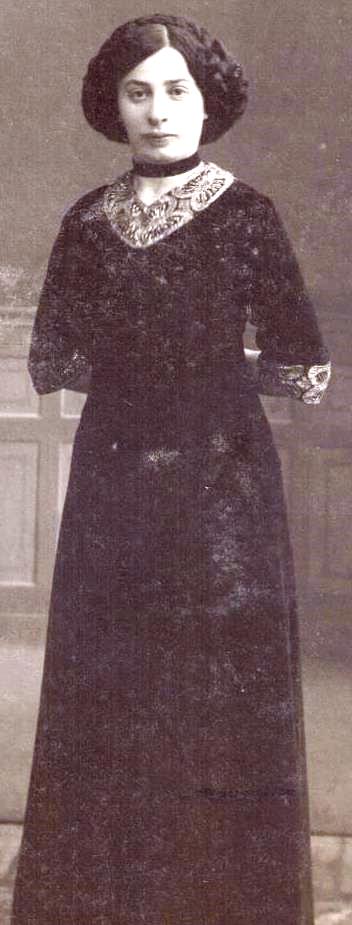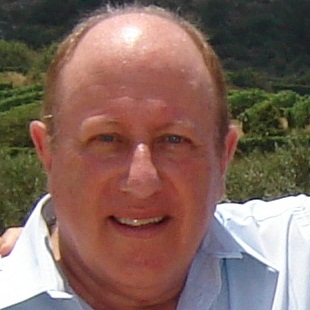
Letters/Discussion Forums

Ten years on, has anything changed?
Published
9 years agoon
By
adminDAVID HERSCH
I publish it in memory of my paternal grandmother Flora Rutkowitz
and whole family that were murdered by the Nazis in Lithuania
The Holocaust was one of the most brutal episodes in world history. Nazi racial policies culminated in the extermination of millions of men, women and children.
The Jews were not the only victims of Nazism. It is estimated that as many as 15 million civilians were killed by this murderous and racist regime, including millions of Slavs and ‘Asiatics’, 200,000 Gypsies and members of various other groups including Jehovah Witnesses. Thousands of people, including Germans of African descent, were forcibly sterilised.

RIGHT: Flora Rutkowitz my paternal grandmother before WWII in Novgorod Russia
These programmes are best seen as a series of linked genocides, each having its own history, background, purpose and significance in the Nazi scheme of things.
The Holocaust was the biggest of the killing programmes and, in certain important ways, different from the others.
The Jews figured in Nazi ideology as the arch-enemy of the ‘Aryan race’, and were targeted not merely for terror and repression but for complete extinction.
Nazi’s failed
The Nazis failed in this aim because they ran out of time, but they pursued it fanatically until their defeat in 1945.
The Holocaust led to widespread public awareness of genocide and to modern efforts to prevent it, such as the 1948 UN Convention on Genocide.
Origins of the Holocaust
The ideas and emotions that lay behind the Holocaust were not new, nor were they uniquely German. The Nazis were the heirs of a centuries-old tradition of Jew-hatred, rooted in religious rivalry and found in all European countries. When the Nazis came to carry out their genocidal programme, they found collaborators in all the countries they dominated, including governments that enjoyed considerable public support. Most people drew the line at mass murder, but relatively few could be found to oppose it actively or to extend help to the Jews.
Though it had ancient roots, Nazi ideology was far from a primitive, medieval throwback – it was capable of appealing to intelligent and sophisticated people. Many high-ranking Nazis had doctoral degrees and early supporters included many eminent people. Anti-Semitism, the new racist version of the old Jew-hatred, viewed the Jews as not simply a religious group but as members of a ‘Semitic race’, which strove to dominate its ‘Aryan’ rivals.
Anti-Semitism proved a convenient glue for conspiracy theories – since Jews were involved in all sorts of ventures and political movements, they could be accused of manipulating all of them behind the scenes. Thus Jews were held responsible for Communism and capitalism, liberalism, socialism, moral decline, revolutions, wars, plagues and economic crises. As the Jews had once been demonised in medieval Europe, so the new anti-Semites (including many Christians) found new, secular ways of demonising them.
1933 – 1939
Soon after they took power, the Nazis began their persecutions with a barrage of anti-Jewish laws, including the infamous Nuremberg Laws (1935), which defined Jews according to ‘racial’ criteria and stripped them of citizenship. Not yet securely in power, however, the Nazis at first refrained from major acts of violence.
The war years
Organised killing began with the outbreak of war in September 1939, but the first victims were not Jews. The Nazis set about killing people with physical and mental disabilities, whom they regarded as a burden on the state and a threat to the nation’s ‘racial hygiene’. About 170,000 people were eventually killed under this so-called Euthanasia programme, which also pioneered techniques and employed many of the people later used to kill Jews.
When the Nazis occupied western Poland in 1939, two-thirds of Polish Jews – Europe’s largest Jewish community – fell into their hands. The Polish Jews were rounded up and placed in ghettos, where it is estimated that 500,000 people died of starvation and disease. Nazi policy at this point was aimed at forced emigration and isolation of the Jews rather than mass murder, but large numbers were to die through attrition.
Mass killing begins
With the invasion of the Soviet Union on June 22 1941, the Nazis launched a crusade against ‘Judaeo-Bolshevism’, the supposed Jewish-Communist conspiracy. Behind the front lines, four police battalions called Einsatzgruppen (operations groups) moved from town to town in the newly occupied Soviet territories, rounding up Jewish men and suspected Soviet collaborators and shooting them. In subsequent sweeps, making heavy use of local volunteers, the Einsatzgruppen targeted Jewish women and children as well. In total, the Einsaztgruppen murdered some two million people, almost all Jews.
The Final Solution
While these massacres were happening, the Nazis elsewhere were laying plans for an overall ‘solution to the Jewish question’. Death camp operations began in December 1941 at Semlin in Serbia and Chelmno in Poland, where people were killed by exhaust fumes in specially modified vans, which were then driven to nearby sites where the bodies were plundered and burnt. 250,000 Jews were killed this way at Chelmno and 15,000 at Semlin.
More camps opened in the spring and summer of 1942, when the Nazis began systematically clearing the ghettos in Poland and rounding up Jews in Western Europe for ‘deportation to the East’. The killing of the Polish Jews, code-named ‘Project Reinhardt’, was carried out in three camps: Treblinka, near Warsaw (850,000 victims); Belzec, in south-eastern Poland (650,000 victims); and Sobibor, in east-central Poland (250,000 victims). Some Jews from Western Europe were sometimes taken to these camps as well, but most were killed at the biggest and most advanced of the death camps, Auschwitz.
Industrial killing: Auschwitz-Birkenau
Originally a concentration camp for Polish political prisoners, Auschwitz was greatly expanded in 1941 with the addition of a much larger camp at nearby Birkenau. In all, Auschwitz-Birkenau and its sub-camps held 400,000 registered prisoners including 205,000 Jews, 137,000 Poles, 21,000 Gypsies, 12,000 Soviet POWs and 25,000 others (including a few British POWs). In this largest and worst of all the Nazi concentration camps, 210,000 prisoners died of starvation and abuse.
But Auschwitz-Birkenau became more than a concentration camp. In the spring of 1942 gas chambers were built at Birkenau and mass transports of Jews began to arrive. Some of the new arrivals were inducted into the camp as registered prisoners, but the great majority were gassed immediately. These gassing operations were greatly expanded in the spring of 1943 with the construction of four purpose-built gas chamber and crematorium complexes, which included such refinements as electric lifts to carry bodies up to the crematoria. Each crematorium could handle 2,000 victims daily. In a nearby group of barracks, nicknamed ‘Canada’ by the prisoners, victims’ belongings were sorted for transportation to the Reich. The victims’ hair was used to stuff mattresses; gold teeth were melted down and the gold deposited to an SS account.
In all about 900,000 people were gassed at Birkenau without ever being registered as prisoners, almost all of them Jews. This brought the total death toll of the Auschwitz complex to about 1.1 million, of whom one million were Jewish.
The end of the Holocaust
The Final Solution moved into its last stages as Allied forces began to close in on Germany in 1944. The Project Reinhardt camps were razed. A prisoner work-gang called the Blobel Commando began digging up and burning the bodies of those killed by the Einsatzgruppen. Prisoners remaining in Auschwitz and other concentration camps were transported or force-marched to camps within Germany. Hardly fit for such an effort, thousands of prisoners on these death marches succumbed to starvation, exhaustion and cold, or were shot for not keeping up the pace.
Jewish prisoners were concentrated at Bergen-Belsen, hitherto not known as one of the worst camps; but in the chaotic final months of the war conditions were allowed to deteriorate catastrophically. When British troops came across the camp on 15 April 1945, they encountered 10,000 unburied corpses, a raging typhus epidemic and 60,000 sick and dying prisoners crammed into overcrowded barracks without food or water.
The outside world
The discovery of Belsen brought home the shocking truth about Nazi atrocities, but the facts had been known for some time. As early as the summer of 1941, British signals intelligence had intercepted and decoded radio messages from German police units co-operating with the Einsatzgruppen, and details of the killings of Jews were included in the monthly summaries that were sent to Churchill. Churchill responded with a speech on August 24 1941 in which he called the massacres ‘a crime without a name’ but erroneously identified the victims as ‘Russian patriots defending their native soil’. Otherwise, these facts were not made public.

LEFT: David Hersch
port from the Jewish Workers’ party in Poland reached London. The report described the massacres in the east and estimated that 700,000 Jews had been killed; but when a Polish courier mentioned this number to a British journalist he was advised to ‘drop a zero or two’ if he wanted to be believed.
Another Polish courier, Jan Karski, reached the west in November 1942, carrying messages from Jewish leaders in Poland. He had himself witnessed the conditions in the Warsaw ghetto and in what he believed to be the Belzec death camp, and was eager to inform the world. Karski saw the British foreign secretary, Anthony Eden, and US President Roosevelt, but they seemed to be more interested in military intelligence than in atrocity stories. Partly as a result of Karski’s mission, however, the Allies agreed to a joint declaration, read to the British Parliament on 17 December, which acknowledged Nazi war crimes and threatened punishment for the perpetrators. Subsequently millions of leaflets were dropped in the course of bombing raids on German cities to inform Germans of the facts, but these had little or no effect.
Britain’s attitude to Jewish refugees from Nazi-controlled areas was strongly influenced by its role as the mandatory power in Palestine, where it had to mediate between Jewish and Arab interests. In December 1941, the Struma, a ship carrying 769 Jewish refugees, left the Romanian port of Constantsa hoping to reach Palestine. Towed into Istanbul harbour when its engines failed, it became the subject of diplomatic discussions between Britain and Turkey. Britain’s chief concern was to discourage what it regarded as an undesirable traffic, and it proposed that the ship be returned to Romania. After ten weeks of wrangling the Struma was towed out to sea, its engines still disabled, where it was sunk by a Soviet submarine. There was one survivor.
Jewish refugees were the subject of two international conferences, at Evian in 1938 and Bermuda in 1943. Neither conference resulted in any concrete action. In general, Britain treated refugees from Nazi Germany as economic migrants, and took in only those who would be of economic benefit to the country. About 10,000 Jewish children were brought to Britain in 1939 under the Kindertransport scheme, and placed with British families, but their parents were excluded and had to pay for their children’s support. The best that can be said for Britain’s refugee policy is that it was less ungenerous than that of most other European states at the time.
Is Forgiveness Possible?
A Jewish Perspective: Can Jewish people forgive the atrocities of the Holocaust? This is a question that has troubled survivors and later generations alike.
Before the war began, most countries were reluctant to take in more than a token number of refugees from Germany. Later, the refusal of the Allies to bomb the railroad tracks leading to Auschwitz or the lack of attempts to destroy the extermination camps were questionable decisions which we now view with concern. Our observance of a National Holocaust Day cannot ignore these ancillary issues, which suggest a shared responsibility for that dark period of history.
Holocaust memorials exist for remembrance and are not intended to make us forgive and forget. Is there an intention here to turn to the victims – the Jews, the Sinti-Roma (gypsies) and other groups sent into the camps – to ask them to stop troubling the conscience of the world? Are we saying: ‘Look what we have done for you. We can’t be fairer than that. Now, stop opening these doors to the past. Move on; forgive and forget. It’s for your own good…’?
Holocaust Memorial Day
National Memorial Day is not intended for Holocaust victims. The Jewish community and other minority groups who suffered have their own day of remembering, their Yom Ha-Shoah. We light our own candles and do not want others to say the Kaddish for us. We are ‘remembrancers’. Professor George Steiner uses this term to underline the basic link between the Jewish people and past generations. The Bible’s emphasis on ‘remembering’ has been a continuous line in our prayers and ceremonies. The congregation and friends join mourners in their grief, but no one can be a substitute in this task.
We do accept the goodwill and the ethical awareness which has created this new national day, and feel that it is an expression of that deeper knowledge of the past which is essential for the future. It was and remains a rebuke to Holocaust deniers and to those who prefer to live in ignorance. It is also a challenge for all countries to practice self-examination and recognise the endemic xenophobia which still lives within the body politic. ‘Know thyself’ is the ancient Delphic lesson for every age. In Judaism, we relearn this teaching on every Yom Kippur, our Day of Atonement.
‘Can we forgive?
Who are we to usurp God’s role?
Between the Jewish New Year and the Day of Atonement, we try to go to any person whom we have wronged and asked forgiveness. But you cannot go to the six million. They are dead and I cannot speak for them. Nor can I speak for God. But you are here at a church service. God’s forgiving grace may touch you, but I am not a mediator, pardoner, or spokesperson for God.’
The shadows still live in the present and will be part of the future. “Who is to give the answer?” The survivors? The Jewish people? The shades of the dead? Examining the Jewish community at that time, researchers noted the conspicuous absence of hate. However, pain, hurt and contempt can be encountered, along with a numbness of feeling, a withdrawal into oneself.
Sixty years later, we are closer to a time of peace between Israel and the German people. There have been many acts of contrition and compensation. We have also noted the Righteous Gentiles of that time, who have been honoured in Israel and in the world. Germany has regained a place in society; yet its task of self-examination is not yet complete.
Christianity has begun to overcome the prejudice that Judaism is a religion of stern justice, confronting a Christianity of gentle love. Love and justice exist in equal measure in our faiths. Arising out of the feeling of natural sympathy, many still feel that the survivors of the Holocaust cannot forgive because they are filled with hatred. We could not have survived if we had been filled with hatred. If we insist that the world must not forget the Holocaust, it is our sense for justice, and our awareness that one cannot blot out the past upon which the present rests.
What about the generations born after the war? You cannot simply remove the years from 1933 – 1945. Germans take pride in the great German traditions of Schiller and Goethe, of Bach and Beethoven, but, in history or in logic, the middle cannot be excluded from the structure. They have also inherited the Holocaust. All of us, observing our National Holocaust Day, carry part of that legacy within our society.
This is a speech I delivered to:
- The Anglican Church, Simon of Cyrene, Plumstead, Cape Town, Sunday 23 January 2005.
- Radio Tygerberg 104FM Friday 28 January 2005.
- Bishops College (Diocesan College, Cape Town) History Society 9 February 2005.
- Holocaust Memorial, Port Elizabeth Jewish Community 2005.




